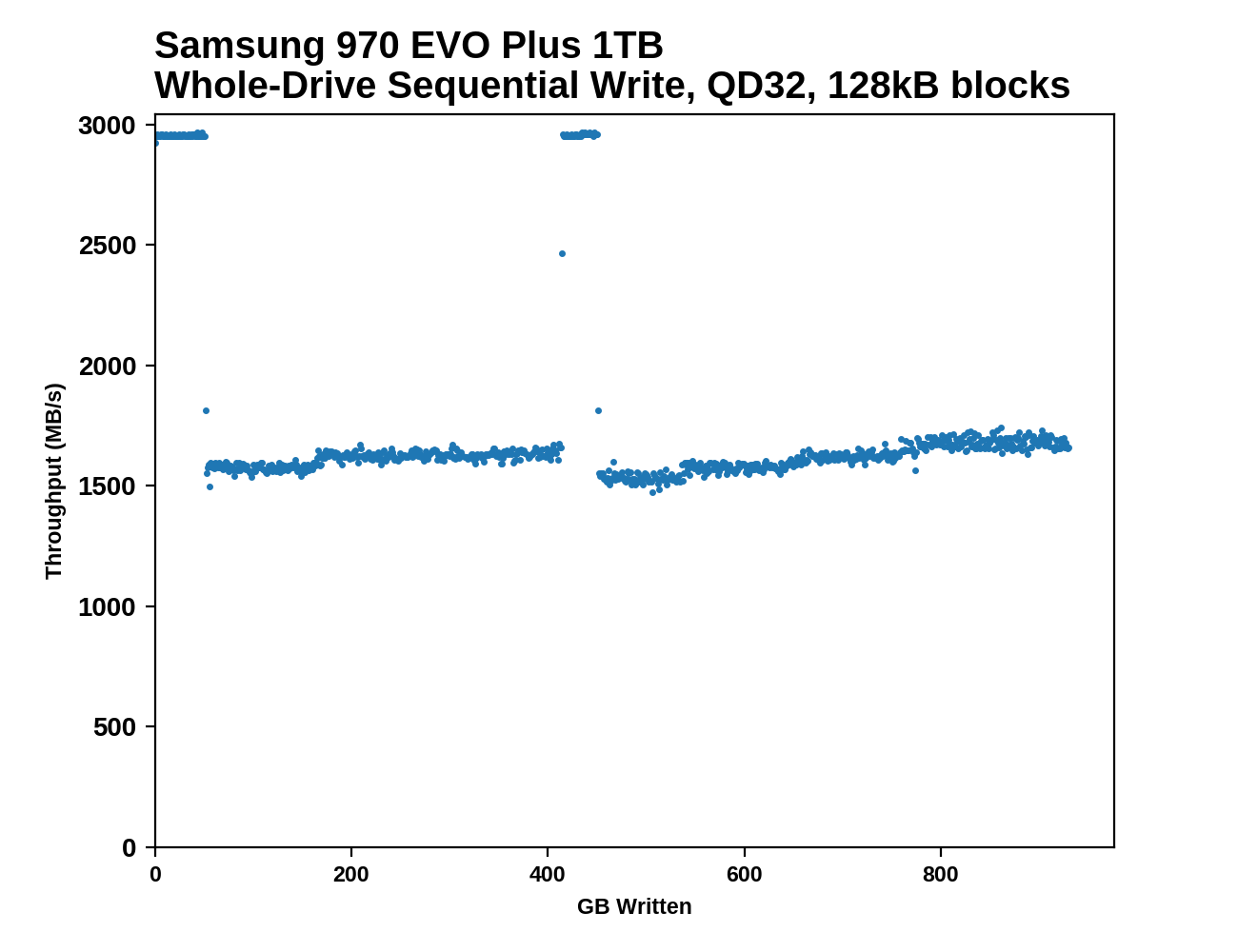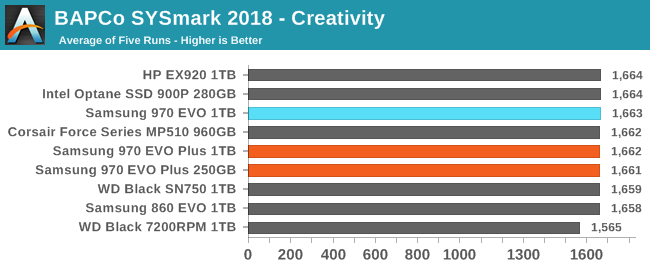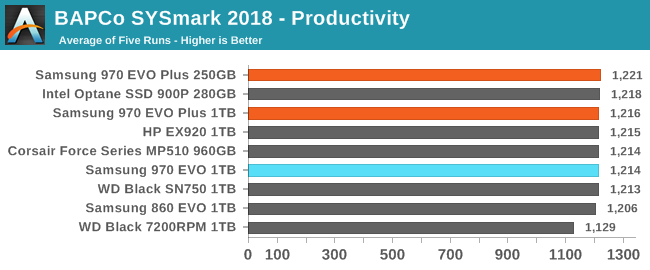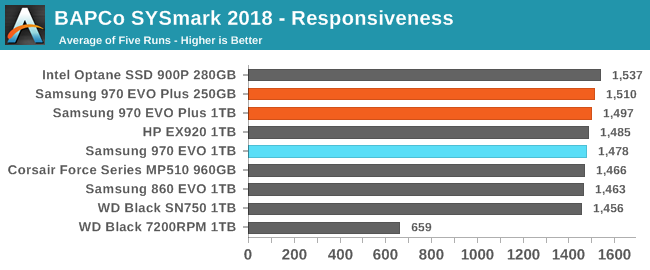The Samsung 970 EVO Plus (250GB, 1TB) NVMe SSD Review: 92-Layer 3D NAND
by Billy Tallis on January 22, 2019 10:00 AM ESTWhole-Drive Fill
This test starts with a freshly-erased drive and fills it with 128kB sequential writes at queue depth 32, recording the write speed for each 1GB segment. This test is not representative of any ordinary client/consumer usage pattern, but it does allow us to observe transitions in the drive's behavior as it fills up. This can allow us to estimate the size of any SLC write cache, and get a sense for how much performance remains on the rare occasions where real-world usage keeps writing data after filling the cache.
 |
|||||||||
Samsung obviously hasn't changed anything significant about the SLC caching behavior for the 970 EVO Plus: the cache initially runs out right on schedule, and the 1TB model still jumps back up to SLC speed for a short while when the drive is a little less than half full. The change to the underlying NAND does provide a performance boost to the write speeds before and after the cache fills up. The 240GB ADATA XPG SX8200 is an outlier among the small drives: it has a very large variable size SLC cache so it maintains high performance longer than the other drives in that capacity class, but once that cache is full it ends with one of the slowest write speeds.
 |
|||||||||
| Average Throughput for last 16 GB | Overall Average Throughput | ||||||||
The improvement to post-SLC sequential write speed isn't quite as big as the 970 EVO Plus specifications promise, but it's still plenty to make it the fastest TLC drive for this test, clearly surpassing the performance of even last week's new WD Black SN750. At the low end of the capacity range, the 250 GB model is well ahead of any other small TLC drive we have tested. It also looks like we are getting quite close to the point where the post-SLC write speed of a small TLC drive can saturate a SATA link, so if Samsung releases another generation of MLC SATA drives for the consumer market it may be impossible to measure any performance advantage over TLC NAND.
BAPCo SYSmark 2018
BAPCo's SYSmark 2018 is an application-based benchmark that uses real-world applications to replay usage patterns of business users, with subscores for productivity, creativity and responsiveness. Scores represnt overall system performance and are calibrated against a reference system that is defined to score 1000 in each of the scenarios. A score of, say, 2000, would imply that the system under test is twice as fast as the reference system.
SYSmark scores are based on total application response time as seen by the user, including not only storage latency but time spent by the processor. This means there's a limit to how much a storage improvement could possibly increase scores, because the SSD is only in use for a small fraction of the total test duration. This is a significant difference from our ATSB tests where only the storage portion of the workload is replicated and disk idle times are cut short to a maximum of 25ms.
| AnandTech SYSmark SSD Testbed | |
| CPU | Intel Core i5-7400 |
| Motherboard | ASUS PRIME Z270-A |
| Chipset | Intel Z270 |
| Memory | 2x 8GB Corsair Vengeance DDR4-2400 CL17 |
| Case | In Win C583 |
| Power Supply | Cooler Master G550M |
| OS | Windows 10 64-bit, version 1803 |
Our SSD testing with SYSmark uses a different test system than the rest of our SSD tests. This machine is set up to measure total system power consumption rather than just the drive's power.



The SYSmark Responsiveness test shows the 970 EVO Plus delivering slightly higher performance than any previous TLC-based SSD, but not quite enough to reach the level of the Intel Optane SSD 900P. Oddly, the 250GB 970 EVO Plus came out a bit ahead of the 1TB model. The other two scenarios—Creativity and Productivity—don't depend on storage performance enough to even show a meaningful difference between the 860 EVO SATA SSD and the fastest NVMe SSDs.
Energy Use
The SYSmark energy use scores measure total system power consumption, excluding the display. Our SYSmark test system idles at around 26 W and peaks at over 60 W measured at the wall during the benchmark run. SATA SSDs seldom exceed 5 W and idle at a fraction of a watt, and the SSDs spend most of the test idle. This means the energy usage scores will inevitably be very close. A typical notebook system will tend to be better optimized for power efficiency than this desktop system, so the SSD would account for a much larger portion of the total and the score difference between SSDs would be more noticeable.

The 970 EVO Plus required a bit less energy to complete a SYSmark run than the original 970 EVO did, but they're still relatively power-hungry compared to other NVMe SSDs, and good SATA SSDs use significantly less power. These differences don't seem like much in the context of our desktop testbed's total power draw, but in a laptop the performance of the 970 EVO Plus does come at some cost to battery life.










35 Comments
View All Comments
kgardas - Friday, January 25, 2019 - link
Thanks for explanation! Actually makes sense indeed. This would also mean that if your workflow is read dominated and you are sensitive on latency than RAID1 of SATA drives may be faster than NVMe. At least if SATA/SAS chip is not a crap.ikjadoon - Tuesday, January 22, 2019 - link
Even a SATA SSD could pump 4 kB random read numbers up, but it'd require pricey SLC. MLC and TLC both have 2x to 4x slower page reads to register vs SLC.latency source: https://www.anandtech.com/show/6337/samsung-ssd-84...
Still, TLC 4 kB random has improved, but not by "leaps and bounds" like 4K write has. The 970 EVO Plus has 53% faster random 4kB reads (sustained) than the MX 500. And even a 960 PRO has 76% faster 4kB reads (sustained) than the MX500.
FWIW, random 4K read performance (both burst and sustained) doesn't benefit much of anything from parallelization. https://www.anandtech.com/bench/product/2229?vs=21... The 250 GB and 1 TB 960 EVO have identical 4K read performance, i.e. within 0.75%. Random 4K write and larger page sizes are about 2x faster on the 1 TB model, however.
Can't vouch for accuracy, but this answer sounds right: https://superuser.com/questions/1168014/nvme-ssd-w...
Alistair - Tuesday, January 22, 2019 - link
The performance is amazing, and I've been buying the 1TB SX8200 for $180 USD before tax. Nothing beats that still.Dark_wizzie - Tuesday, January 22, 2019 - link
1tb ex820 for $160 after tax and shipping beats it.palindrome - Tuesday, January 22, 2019 - link
You mean EX920 and it has been as low as $153 recently (before tax).gglaw - Tuesday, January 22, 2019 - link
Not too long ago it was $135 twice with the Ebay and Rakuten 15% coupons. $155 range seems almost every other week now and frequent enough I'd even consider it the typical selling price. (Very few people who follow tech would actually pay $180 for it). Can't beat this for consumer use with the small performance differences with current gen drives. When the EX950 and SX8200 Pro phase it out and drop to the same price points, they'll replace it as best consumer deals so I don't see the new Samsung or WD having a place in my line-up.If for some purpose I can find a use for something more expensive, it'd have to be the next gen 970 Pro (Plus?) if it's a major upgrade.
** A - R ** - Wednesday, January 23, 2019 - link
https://news.samsung.com/global/samsung-electronic...Billy, Specs in the official site mentions MLC, here I see it's TLC ! ?
Could You please verify it.
olafgarten - Wednesday, January 23, 2019 - link
It says 3 bit MLC, meaning TLC.mortenge - Wednesday, January 23, 2019 - link
Why do you bring Optain into the mix and not the 970 PRO, when all we care about is EVO vs PRO?alfatekpt - Wednesday, January 23, 2019 - link
The review should include 970 EVO 250GB numbers for comparison.